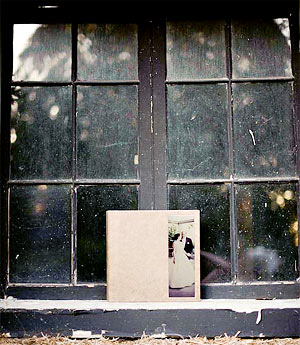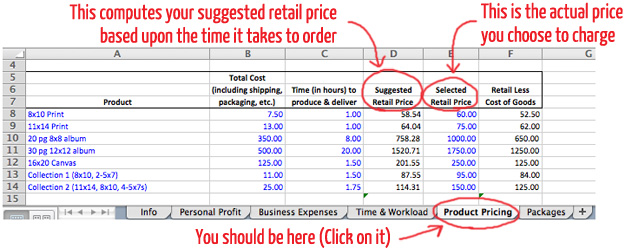 This post is Part 5 of The Modern Tog’s Photographer’s Pricing Guide series. Here’s the link to Part 1 of the Pricing Guide in case you missed it.
This post is Part 5 of The Modern Tog’s Photographer’s Pricing Guide series. Here’s the link to Part 1 of the Pricing Guide in case you missed it.
There are many different ways to do pricing for your products that vary based upon what kind of business model you are using. For this pricing guide, we’re going to use the amount of time it takes you to place an order to help determine how much you should be charging in order to make it worth your time.
The benefit of doing it this way is that you are not wasting a bunch of time placing small orders and only making a little bit of money when you could have otherwise have been using that time to shoot more sessions at a higher profit. This makes sure you’ve priced your products so that even small orders are profitable.
We’ll be looking at how to set your price both for A la Carte items as well as items that are offered together in a collection.
Individual items: A la Carte list
Let’s look at the individual items that you would offer on an A la Carte pricing list first. Consider each item individually as if it were the only product ordered. If you do not offer an A la Carte pricing list, you can skip to the next section where we discuss product collection pricing.
For each product you offer, determine how much time it takes you in hours to deliver this product. You need to take all of your time into account – time spent taking the order from the client (this may be automated if you use a photocart of some sort), time doing additional editing or sharpening, time spent ordering the product, packaging the product, and dropping the product into the mail. Any time you spend working on the order should be included.
Next, list the total cost for that item only. You’ll need to take into any fees paid to your proofing gallery, what it costs you to buy that item, shipping costs, packaging costs, minimum lab charges, and any other costs that may apply.
Save this list – we’ll come back to it in a few moments.
Product collections
Because the time it takes to order a single print verses ten prints is not terribly different, you can offer collections of prints for a lower cost.
If you’re using a collection strategy from something like Easy as Pie, this is where you are able to change the prices for the various collections that you are creating.
List out the product collections that you offer. For each collection, determine the total amount of time and cost it takes you to prepare and deliver this collection just like we did above for the individual items.
Determine your final price
To find your suggested retail price, take your non-shooting hourly rate (computed in the prior post) times the amount of hours it takes you to place the order for each item on both your A la Carte list and your list of product collections. Then add on the costs that apply to that item. This is your suggested retail price.
If you’re using the Photographer’s Pricing Guide Workbook, you can enter your A la Carte items and collections in the list in column A of the Product Pricing tab. Put the total cost in column B, the time (in hours) in column C and your suggested retail price will be computed in column D automatically.
Using the number you just computed, select the retail price that you will use. Whether you stay near the suggested price or stray from it will depend on the business model that you decide to use, so this should be used as a guide for making sure that you are charging enough to make it worth your time. At the very least, I’d take the suggested price and round it to the nearest whole dollar (or nearest 5 dollars if it’s over $100). You’ll enter this in column E of the Photographer’s Pricing Guide Workbook. This is also where you’ll adjust your prices for upper collections if you use the Easy as Pie model.

Finally, you’ll need to compute what I’m going to call your “Retail Less Cost of Goods” amount. This is simply your selected retail price minus the cost of goods. So if you are selling a print for $100 and it costs you $20, then your Retail Less Cost of Goods amount is $100 – $20 = $80. We’ll use this in the next part of the pricing guide when we talk about packages. This is computed automatically in column F of the Photographer’s Pricing Guide Workbook.
Things to consider as you select your final price
Similar items on the A la Carte list may have suggested retail prices that are very close to each other. This is because the time it takes to order them is about the same and the cost difference between them is very low. For example, your 4×6 print may have a suggested retail price that is within a few dollars of the suggested retail price for an 5×7 print. For this reason, I charge the same for all prints 5×7 and smaller. This way if they order a 4×6, it’s because they really want a 4×6 and aren’t just trying to save some money.
You may also feel that small prints are overly expensive, but this is what you’d need to charge if only one single small print was ordered to make it worth your time. If you’d like to lower this price, you may consider applying a minimum purchase amount to A la Carte orders. If you do this, you can select a lower price to charge since people will in effect be creating their own custom collection.
If you think that the savings gained on collections verses what their cost would be if ordered from the A la Carte list is too high, so you may want to increase this price as well. Or you can simply select a nice round number near the suggested retail price and know that you’re still making enough for the order to be worth your time.
In the next post, we’ll talk about how to set up photography packages for the various types of shoots you offer and how to change them around for different business models.

